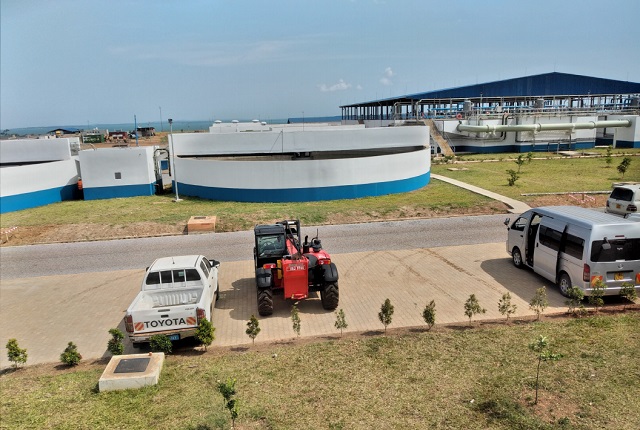
New hi-tech Katosi plant cheaper, cleaner
Kampala, Uganda | RONALD MUSOKE | Sprawled on 25 acres near the shores of Lake Victoria in a quiet village in Mukono district and about 50km east of Kampala, the new Katosi water treatment plant is designed to produce 240 million litres per day. It now pumps about 160 million litres of water per day.
Add that to the 240 million litres that the existing water pumping complex at Ggaba on the south eastern tip of Kampala city already pumps daily, and Kampala’s daily water supply suddenly shoots up to about 400 million litres.
Until recently, the water demand within the Greater Kampala Metropolitan Area (GKMA) was estimated to be between 280 million litres and 300 million litres per day. Greater Kampala includes the Kampala city centre and the inner suburbs, the outer dormitory towns and suburbs, peripheral towns and peri-urban extension to Mukono, Wakiso and Mpigi district.
Without the new Katosi plant, the area suffered a water supply deficit of 40-60 million litres per day. With the new plant, which is already supplying water to homes, businesses and industries, the Kampala area now has surplus daily water pumping capacity of about 200 million litres.
The overstretched Ggaba system has now been relieved of the extra demand, and is currently being used to supply the southern, western and central parts of the Greater Kampala Metropolitan Area. This has resulted into improved water supply reliability in that part of Kampala.
The so-called “dry-zones”; suburbs and peri-urban areas of Greater Kampala that previously suffered perpetual water supply challenges can now expect some relief. These areas include Kampala suburbs like Sonde, Kyaliwajala, Mbalwa, Namugongo, Kireka, Namanve, Mutungo, Kungu, Nsasa, Kasangati, Gayaza, Najjera, Kiwatule, and Naalya and areas near Kampala in Mukono and Wakiso districts. These areas now are now connected to the National Water and Sewerage Corporation (NWSC) system and have water 24/7.
Nicholas Ariho, a resident of Kyanja, one of the targeted suburbs in eastern Kampala told The Independent on Sept. 02 that before July, this year, water supply in his area used to be unreliable but around August, the supply suddenly stabilized.
“What we are contending with now is dirty water in the pipes,” he said.
Ariho might soon see the dirty water problem also disappear soon, according to the NWSC Managing Director, Silver Mugisha. Mugisha says Kyanja residents and surrounding suburbs will get clean water within the next one month.
“When you hear people say they are still experiencing water access challenges, they have to know this is still work in progress,” Mugisha said.
Mugisha said NWSC engineers are still laying distribution mains to send the water to the entire Kampala Metropolitan service area.
Mugisha says plans are already underway to serve customers along Katosi road, Kisoga in Mukono district and to the neighbouring district of Buikwe.
“We now have excess capacity; what we don’t have now is enough distribution system to make sure that everybody gets water,” he says.
He said the current water supply is sufficient enough to meet the needs in the Greater Kampala Metropolitan Area for the next 10-15 years.
When he spoke, Mugisha was on Aug. 27 showing Sam Cheptoris, the Minister of Water and Environment, around the new plant. Cheptoris was on a familiarization tour of the water works, possibly assessing its readiness for official opening sometime this year by President Yoweri Museveni.
The Katosi Water Plant took 30 months to construct by French contractors, Sogea-Satom. The French handed it over to Uganda’s water parastatal in July this year. The NWSC Board Chairman, Badru Kiggundu, who was also present told journalists that, for him, completion of the Katosi water project “is like a dream that has now come true.”
He said the new plant also solves the huge problem of suppressed demand in Kampala; where people needed water but there was no water to serve them. He repeated what Mugisha had said; that water was now available but the new problem was how to get the water from Katosi to the homes, businesses, and industries that need it.
“We are going to resolve all the water supply challenges in Kampala city. We are happy to note that some customers, previously in ‘dry zone’ areas are already getting water,” Kiggundu said. (⏩ Pg 2)
 The Independent Uganda: You get the Truth we Pay the Price
The Independent Uganda: You get the Truth we Pay the Price


